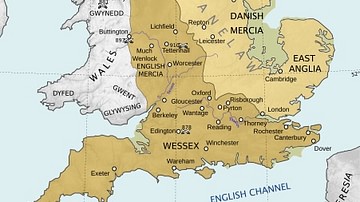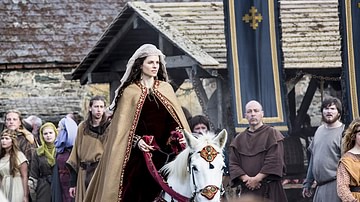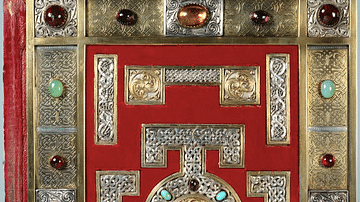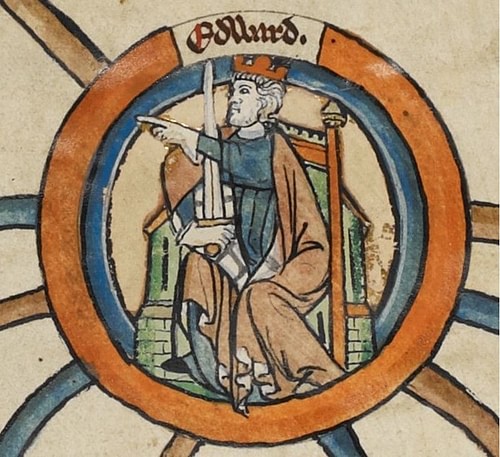
Edward the Elder (r. 899-924) was the son of Alfred the Great (r. 871-899) and the King of the Anglo-Saxons in the early 10th century. He is known for his military victories over the Vikings of East Anglia and the East Midlands and for consolidating his dynasty's control over southern England.
In 865, about a decade before Edward was born, the Great Heathen Army invaded England, destroying the royal dynasties of several English kingdoms, including East Anglia, Mercia and Northumbria and establishing Viking rule across these territories. It fell upon Edward's father, King Alfred of Wessex, to lead the English resistance. He defeated the Vikings at the Battle of Edington in 878 and agreed to a peace treaty with their leader, Guthrum (d. 890), who retreated east to rule over much of the territory conquered by the great army, commonly referred to as 'The Danelaw'. Alfred would spend the next two decades fortifying Wessex, reforming the army and promoting learning and literacy amongst his subjects. He also brought Mercia under his overlordship, after which he took the title 'King of the Anglo-Saxons', denoting his rule over both the Mercians and the West Saxons.
Edward succeeded his father in 899. Most of what we know of his reign comes from a collection of land charters and the Anglo-Saxon Chronicle, which presents him as a relentless and successful warrior-king. His epithet, 'the Elder', was not used during his life but was later used to distinguish him from his great-grandson, Edward the Martyr, King of England (r. 975-978). Though well-regarded as a ruler by medieval chroniclers and modern historians, Edward often remains in the shadow of his more illustrious father. However, there has been more interest in Edward recently due to the TV series The Last Kingdom, in which he is portrayed by Timothy Innes. Yet, the show depicts Edward as a king struggling to step out of his father's shadow, with many of his achievements being accredited to the show's protagonist, Uhtred of Bebbanburg.
Early Life
Edward was born c. 874-877. His parents, Alfred and Ealhswith (d. 902), a Mercian noblewoman, were married in 868. In addition to Edward, the couple had four more children: Aethelflaed (d. 918), who married the Ealdorman of Mercia and later ruled Mercia herself; Aethelgifu, who became the Abbess of Shaftesbury; Aelfthryth (d. 929) who married the Count of Flanders and another son, Aethelweard (d. 920). The earliest mention of Edward in contemporary sources comes from Bishop Asser – a Welsh priest and scholar at Alfred's court – in his work the Life of King Alfred. Asser recounts that Edward spent his youth at the king's court, studying religious and secular texts and was taught to show "humbleness, affability, and gentleness towards all." Edward was also trained in warfare, and while still in his teens, led the West Saxon army to victory over the Vikings at the Battle of Farnham in 893. Around the same time, he appears to have become a regular member of the king's council and married a woman named Ecgwynn, of whom we know little about, although the couple had a son, Aethelstan (d. 939), and a daughter, Edith.

In the final years of his father's reign, Edward was granted the title 'rex' (king), suggesting he had been appointed co-king alongside his father or, more likely, was given his own kingdom in Kent to provide him with experience ruling before he succeeded his father. Primogeniture (father-to-son succession) had not firmly been established in Wessex; succession was still elective to a certain degree, with the crown passing to the aetheling (prince), favoured by the nobility. Edward's main rival for the throne was his cousin Aethelwold (d. 902), the son of Alfred's brother, King Aethelred of Wessex (r. 865-871). As much of the West Saxon nobility owed their position to Alfred, they were naturally inclined to support Edward's succession, but his experience in warfare and royal administration went a long way to secure their support.
Succession & Early Reign
Alfred died on 26th October 899. As expected, Edward’s succession was supported by the West Saxon nobility. However, unsatisfied with his new king, Aethelwold rebelled against Edward. He was swiftly chased out of Wessex, returning a couple of years later with the backing of several Viking leaders from York and East Anglia. Despite defeating a section of Edward’s army at the Battle of the Holme in 902, Aethelwold was killed in combat, ending his rebellion. In Aethelwold’s absence, Edward had moved to consolidate his rule in Wessex. On 8th June 900, he held his coronation at Kingston-upon-Thames. Around the same time, he set aside Ecgwynn and married Aelfflaed, daughter of a former Ealdorman of Wiltshire, who perhaps being of higher status than the king’s first wife, was considered a more suitable consort. Having secured Wessex, Edward turned his attention to Mercia. The ruler of Mercia, Ealdorman Aethelred (r. 881-911), inherited a diminished kingdom weakened by Viking attacks and war with the Welsh. He submitted to King Alfred in 883, accepting West Saxon overlordship, although he retained a considerable degree of autonomy in Mercia. Their alliance was further cemented by Aethelred’s marriage to Alfred’s daughter, Aethelflaed and the transfer of London to Mercian control in 886. Aethelred was already well acquainted with his brother-in-law, Edward, having campaigned alongside him against the Vikings in 893. He was content to continue recognising West Saxon authority over Mercia under its new king, just as he had under Alfred. In 903, he and his wife attended Edward’s court and were acknowledged as holding “rulership and power over the Mercian people under the aforementioned king [Edward].” In a final gesture of dynastic unity, Edward handed over his son, Aethelstan, into the care of Aethelred and Aethelflaed, further demonstrating his commitment to the Mercian-West Saxon relationship.
Securing the church's support for his succession was also vital in Edward's early reign, solidifying his legitimacy as king. Fortunately, Archbishop Plegmund of Canterbury (r. 890-914/923), a devoted follower of King Alfred, was content to support the new king’s rule and oversee his coronation. Edward also took a hands-on approach to church reform. After consulting the papacy in 908, he worked with Archbishop Plegmund to restructure the West Saxon church, dividing the two large traditional West Saxon bishoprics of Sherborne and Winchester into five bishoprics, creating new sees at Crediton, Ramsbury and Wells. This made each diocese smaller, ensuring each bishop could better administer his diocese and offer improved pastoral care to the West Saxons.
The Battle of Tettenhall
Conflict with the Vikings continued after the Battle of the Holme in 902, with peace only being agreed upon in 906. Yet, three years later, Edward reignited the war, dispatching an army of Mercians and West Saxons into the Danelaw. He intended to capture the remains of Saint Oswald from Bardney Abbey in Lincolnshire. St Oswald was a 7th-century English king who was martyred in battle against pagans, making him an important saint and figure of unity amongst the English. His remains were taken to the Mercian church at Gloucester, which was renamed St Oswald's Priory in his honour. The king's army remained in enemy territory for five weeks, raiding throughout the countryside. This provoked a retaliatory strike from the Viking leaders of York, who launched a counter-raid deep into Mercia. Edward ordered the Mercian and West Saxon armies to intercept the Vikings as they retreated northwards. Both sides met in Staffordshire in August 910, fighting at the Battle of Tettenhall, where, according to the Anglo-Saxon Chronicle, Edward's army "put the [Viking] army to flight and killed many thousands of its men." Among the dead were two Danish kings, Eowils and Halfdan, along with several earls and chieftains from the Danelaw. The defeat considerably weakened the Viking threat coming from York, leaving the Vikings of the southern Danelaw isolated and in danger in the coming years.
Aethelred of Mercia passed away a year after the battle and was buried at St Oswald's Priory in Gloucester. With no male heir, Aethelflaed succeeded her husband, taking the title ‘Lady of the Mercians’. This was a straightforward decision for the Mercians as Aethelflaed had already been acting as regent/co-ruler on behalf of her husband, as he was ill and, at times, incapacitated toward the end of his life. Edward was content to allow the Mercians to choose Aethelred's successor by themselves and must have been pleased that they supported his sister's succession, which ensured the continuation of his relationship with Mercia.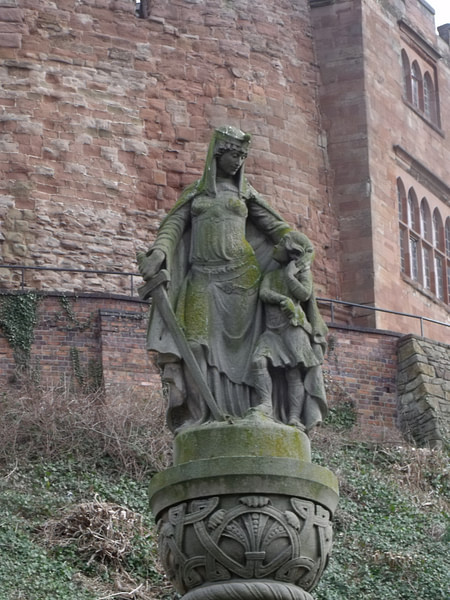
The Danelaw Campaign
Shortly after Aethelflaed’s succession, she transferred the lands surrounding Oxford and London to Edward’s control. This possibly stemmed from King Alfred’s earlier grant of London to Ealdorman Aethelred in 886, with these lands reverting to Wessex upon Aethelred’s death. However, it may have also been in preparation for an offensive campaign into the Danelaw, which Edward had begun planning. The two siblings agreed to divide military responsibilities, with the lands transferred to Edward acting as a springboard from which he could launch his invasion into the Viking-held East Anglia and the Southeast Midlands. Aethelflaed, meanwhile, would focus on defending the Welsh border, repelling Norse-Irish incursions in the northwest and fighting the Danish towns to the east of her borders. Edward’s strategy relied on building or strengthening burhs (fortified towns), either on his borders, from where he could launch attacks into nearby Viking territory, or once he conquered territory, they could be used to control the surrounding land and population.
Edward's campaign progressed gradually. From 912 to 914, he built new burhs at Hertford and Buckingham and to the east, he made inroads into Viking-held Essex, establishing a burh at Witham and later at Maldon. Some Viking leaders, perhaps fearing Edward’s army and unable to resist his advances, surrendered peacefully. Notably, Thurkytel, Jarl of Bedford, had submitted to the king by 915 and allowed him to fortify Bedford. The Viking armies generally avoided pitched battles with Edward, with most of the conflict taking place at fortresses. This is demonstrated in 917 when a coalition of Viking armies mounted assaults on Edward’s new border burhs at Towcester, Bedford, Maldon and Wigmore (unknown location, likely in Essex), all of which were defeated by the town’s defenders. In the same year, Edward took a more aggressive stance and conquered several Danish strongholds, including Tempsford and Colchester. The siege of Tempsford was a decisive battle, resulting in the deaths of a Viking king and two earls. Eventually, by the end of 917, several leaders in the southern Danelaw sued for peace and gave oaths of loyalty to Edward. The campaign was later praised by Sir Frank Stenton as “one of the best-sustained and most decisive campaigns in the whole of the Dark Ages” (335). For Edward, it had been a grand success, defeating the Viking threat in East Anglia, Essex and Northamptonshire and proving his ability as a military leader and strategist.
Mercia & the North
To the west, Aethelflaed’s military endeavours mirrored the successes of her brother. She imposed Mercian power over the Welsh and constructed burhs on her borders to bolster her defences. She captured the Danish strongholds of Leicester and Derby, and by 918, began negotiations to bring York under her control. However, she died on 12th June 918 at Tamworth and was buried at St Oswald’s Priory beside her husband. Her daughter, Aelfwynn, was initially supported as Mercia’s new ruler. However, by December 918, perhaps believing his niece was not as effective a ruler as her mother had been, Edward took direct control of Mercia, deposing Aelfwynn and sending her into Wessex, after which her life was unrecorded. The role of the Mercian nobility in this transfer of power is uncertain, but they do not appear to have opposed Edward taking power. Edward was, after all, half-Mercian through his mother and likely commanded the respect of the Mercian army, having previously campaigned alongside them. However, the medieval chronicler Henry of Huntingdon questioned Edward's conduct, thinking the king cared little for "the justice of the act" when he deposed Aelfwynn. Later events would demonstrate that some in Mercia shared this sentiment.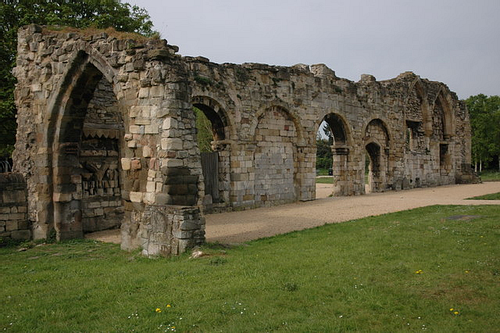
Upon taking control in Mercia, Edward received the submission of several Welsh kings who had previously acknowledged Aethelflaed’s overlordship. Afterwards, he resumed his campaign in the east; having taken control of Stamford earlier in the year, he pushed north and captured Nottingham, where much of the Danish settlers of the East Midlands submitted to his rule.
Around the time of Edward’s accession to Mercia, King Ragnall (r. 918-921), a Viking leader infamous for terrorising the Irish, the Northumbrians and the Scots, established himself as King of York, ending any prospect of the town coming under Mercian control. To contain the threat Ragnall posed, Aethelflaed had previously formed alliances with the kingdoms of Strathclyde and Scotland and built burhs on her northern border. Edward inherited her strategy, building new burhs at Bakewell, Manchester and Thelwall and continued to cooperate with her allies in the north. This alliance seemed to have led to a diplomatic gathering in Bakewell in 920. The Anglo-Saxon Chronicle describes the meeting as follows: “Edward was chosen for father and for lord by the king of the Scots, and by the Scots, and King Ragnall, and by all the Northumbrians, and also the king of the Strathclyde Britons, and by all the Strathclyde Britons.” The chronicle likely overstates Edward’s role in the agreement outlined. Rather than a general submission to Edward by the northern rulers, the agreement at Bakewell was likely a peace treaty, which Edward and his northern allies had pressured Ragnall into accepting. While bringing peace to the north was an impressive achievement, it is doubtful how long the Bakewell treaty lasted. Ragnall died the following year in 921 and was succeeded in York by his brother, King Sihtric (r. 921-927), who does not appear to have reaffirmed peace with Edward and his allies.
Family, Death & Legacy
Edward spent much of his life on the frontlines, leading his army and overseeing the construction of fortifications. He was certainly absent from Wessex for long periods of his reign. However, he remained in regular contact with his wife, Aelfflaed, as the couple had eight children, adding to the two from Edward’s first marriage. Aelfflaed, however, was set aside in 919, and Edward married Eadgifu, daughter of a former Ealdorman of Kent. Together they had four children, making Edward a father of 14 in total.
There is some evidence of Mercian discontent toward the end of Edward’s reign, as Chester revolted against his rule in 924. Edward swiftly suppressed the revolt before retreating to his nearby estate at Farndon, Cheshire, where he died of unknown causes on 17th July 924. His body was taken south and buried at New Minster, Winchester, a church he founded in memory of his father. Edward’s succession plans remain uncertain, but seem to have entailed some form of power-sharing arrangement between his eldest son, Aethelstan, in Mercia and his second son, Aelfweard, in Wessex. However, Aelfweard died within weeks of his father’s death, allowing Aethelstan to take control of Mercia and Wessex. Within three years of his reign in 927, Aethelstan seized York and was recognised as the first King of England. He was succeeded by his younger brothers, King Edmund (r. 939-946) and King Eadred (r. 946-955), who successfully continued Aethelstan’s efforts to establish control of northern England. Edward’s daughters also furthered the influence of his kingdom, marrying into leading royal and ducal families across Europe. Most notably, his daughter, Eadgifu, married Charles the Simple, King of West Frankia (r. 898-922), and another daughter, Eadgyth, married Otto the Great, the future King of Germany (r. 936-973). However, some of his daughters instead opted for a religious life and entered nunneries at Winchester and Wilton.
Edward is primarily remembered for his military conquests of East Anglia and the East Midlands. This expansion of territory allowed what may have been his father's aspiration for English unification to become a reality under Edward’s successors. Yet Edward was more than just an effective warrior who won battles and expanded his borders. He was evidently interested in administrative reform, as seen in his reorganisation of the West Saxon church and is often credited with introducing the shire system to Mercia. While Edward is not often thought to share his father’s interests in scholarly pursuits, many of Alfred’s former tutors, including Bishop Asser and Archbishop Plegmund, were senior advisors to Edward, and according to the 12th-century chronicler William of Malmesbury, Edward’s sons were educated so that “they might succeed to govern the state, not like rustics, but philosophers.” He was also clearly an effective statesman who maintained stability in Wessex despite frequent absences from his homeland. He cooperated with his allies to pursue mutual objectives against Viking opposition and, in establishing rule over Mercia in 918, centralised control over the growing English kingdom for himself and his successors.




